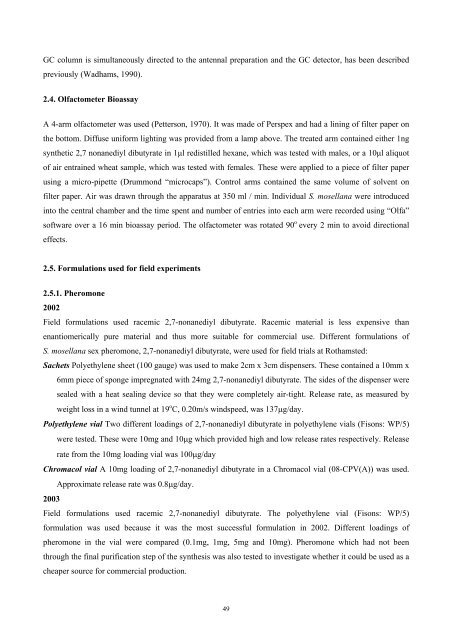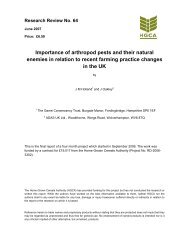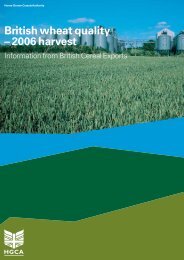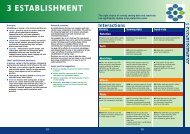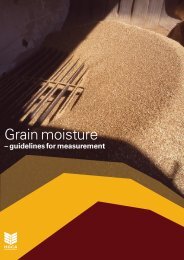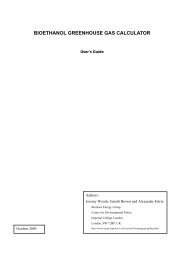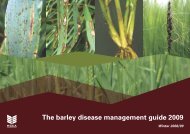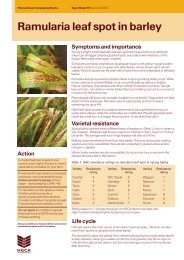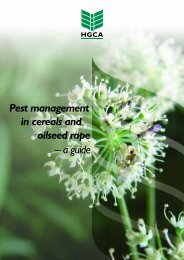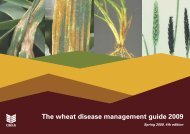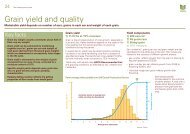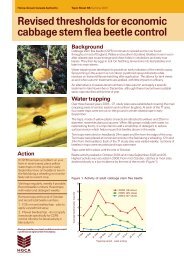Integrated control of wheat blossom midge - HGCA
Integrated control of wheat blossom midge - HGCA
Integrated control of wheat blossom midge - HGCA
Create successful ePaper yourself
Turn your PDF publications into a flip-book with our unique Google optimized e-Paper software.
GC column is simultaneously directed to the antennal preparation and the GC detector, has been describedpreviously (Wadhams, 1990).2.4. Olfactometer BioassayA 4-arm olfactometer was used (Petterson, 1970). It was made <strong>of</strong> Perspex and had a lining <strong>of</strong> filter paper onthe bottom. Diffuse uniform lighting was provided from a lamp above. The treated arm contained either 1ngsynthetic 2,7 nonanediyl dibutyrate in 1µl redistilled hexane, which was tested with males, or a 10µl aliquot<strong>of</strong> air entrained <strong>wheat</strong> sample, which was tested with females. These were applied to a piece <strong>of</strong> filter paperusing a micro-pipette (Drummond “microcaps”). Control arms contained the same volume <strong>of</strong> solvent onfilter paper. Air was drawn through the apparatus at 350 ml / min. Individual S. mosellana were introducedinto the central chamber and the time spent and number <strong>of</strong> entries into each arm were recorded using “Olfa”s<strong>of</strong>tware over a 16 min bioassay period. The olfactometer was rotated 90 o every 2 min to avoid directionaleffects.2.5. Formulations used for field experiments2.5.1. Pheromone2002Field formulations used racemic 2,7-nonanediyl dibutyrate. Racemic material is less expensive thanenantiomerically pure material and thus more suitable for commercial use. Different formulations <strong>of</strong>S. mosellana sex pheromone, 2,7-nonanediyl dibutyrate, were used for field trials at Rothamsted:Sachets Polyethylene sheet (100 gauge) was used to make 2cm x 3cm dispensers. These contained a 10mm x6mm piece <strong>of</strong> sponge impregnated with 24mg 2,7-nonanediyl dibutyrate. The sides <strong>of</strong> the dispenser weresealed with a heat sealing device so that they were completely air-tight. Release rate, as measured byweight loss in a wind tunnel at 19 o C, 0.20m/s windspeed, was 137µg/day.Polyethylene vial Two different loadings <strong>of</strong> 2,7-nonanediyl dibutyrate in polyethylene vials (Fisons: WP/5)were tested. These were 10mg and 10µg which provided high and low release rates respectively. Releaserate from the 10mg loading vial was 100µg/dayChromacol vial A 10mg loading <strong>of</strong> 2,7-nonanediyl dibutyrate in a Chromacol vial (08-CPV(A)) was used.Approximate release rate was 0.8µg/day.2003Field formulations used racemic 2,7-nonanediyl dibutyrate. The polyethylene vial (Fisons: WP/5)formulation was used because it was the most successful formulation in 2002. Different loadings <strong>of</strong>pheromone in the vial were compared (0.1mg, 1mg, 5mg and 10mg). Pheromone which had not beenthrough the final purification step <strong>of</strong> the synthesis was also tested to investigate whether it could be used as acheaper source for commercial production.49


